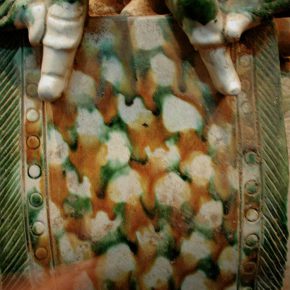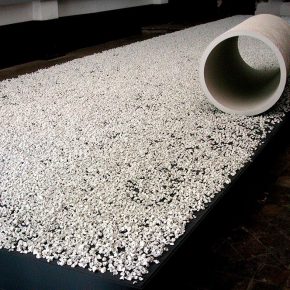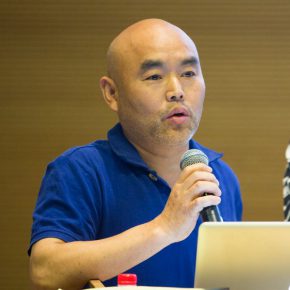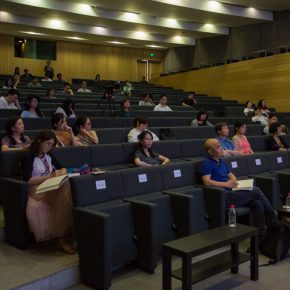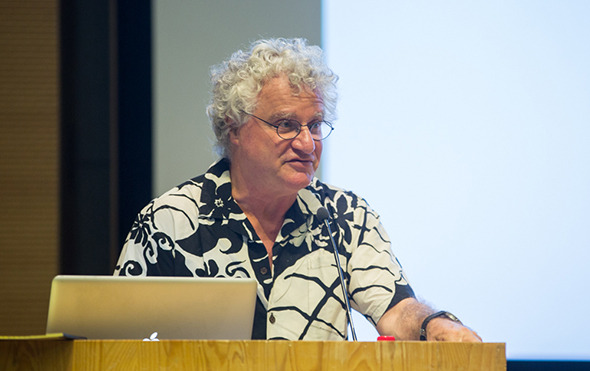
At 3:00 pm on June 2, 2017, jointly organized by the School of Plastic Arts, CAFA, Beijing Minsheng Art Museum and the National Archives of Contemporary Art, the lecture of “From Material (Process) to Space” was held at CAFA Art Museum. Prof. Jacques Kaufmann, Chairman of International Ceramic Art Society at the United Nations Educational, Scientific and Cultural Organization, former Director of the Department of Ceramics of Vevey Applied Art School, Switzerland was the speaker, Zhang Zikang, Director of CAFA Art Museum and Prof. Lv Pinchang, Director of the Department of Sculpture, CAFA served as the hosts.
At the beginning of the lecture, Zhang Zikang introduced Jacques Kaufmann in detail, and invited Kaufmann’s friend Prof. Lv Pinchang, Director of theDepartment of Sculpture to preside over the academic lecture. Prof. Lv Pinchang said that, Kaufmann was a leader in contemporary ceramic art, and he deeply understood the Chinese ceramic culture, his works using the installation to express the relationship between man and space, were now at the forefront of ceramic art.
After that, Kaufmann officially started his lecture. He first told the audience his ultimate artistic ideal in life. In his opinion, ceramic art joins different cultures of the world to promote mutual understanding between people, as well as peace in the world, this is his pursuit in life. Kaufmann said that he was once a professor in the past, and now he was a traveler and a dreamer, his life has always involved action to practice his ideal.
Prof. Kaufmann proposed a concept of energy. He believes that the first thing for people to exchange is energy. This energy enters our consciousness and soul which then constitutes our knowledge of the other side. He defines beauty which is also a pure energy as something that comes from the artist’s heart and soul with the artist pouring this into the work.
And then, Prof. Kaufmann talked about his creative ideas. His creation is divided into three parts: process, material and space. He believes that once any factor is changed, the whole work will be completely different. He also emphasized the subjectivity of the creator in the creation. He argued that the so-called creativity was to change one of the three elements of the creation, altering it.
After talking about the theory, Kaufmann talked about his works. His current work is created based on his previous three periods of learning, which are three rebirths of artistic experience. First of all he graduated from a college in Geneva; secondly he went to work in Africa in 1984 for two and a half years, thirdly he went to China in the 1990s.
In Africa, a group of ceramic bricks which were disorderly piled has attracted Kaufmann. After returned home, he made a series of installations – he borrowed some bricks from the brick factory, and then gave the bricks back to the factory after the end of the exhibition. The reason why he did it was in order to explore the relationship between man and space. For example, the work “Separation” means “detachment”, which is based on the birth of Kaufmann’s son, and he thought his wife's accouchement was the first separation of the newborn and the mother.
When he came to China in the 1990s, Kaufmann saw some tri-colored glazed potteries of the Tang Dynasty. Although he hardly knew Chinese culture, he created the work named “Tang” because of the curiosity of the tri-colored glaze of the Tang Dynasty and the love of Chinese ceramic culture.
Prof. Kaufmann’s masterpiece is also closely related to China. He was heavily shocked when he visited the Mausoleum of the First Qin Emperor. During the visit, the heads of the terracotta warriors attracted him which led to him cooperating with an artist and spending 3 or 4 weeks together with him, spending the minimal amount of time on the creating of terracotta warriors as much as possible, creating in total 156000 pieces. After that he has also held many exhibitions on the same theme all over the world, and the little faces of theterracotta warriors have become his masterpiece.
In China, Kaufmann has designed a lot of works. For example, “The Mountain Moving”, and “Looking for Light” in an academy in Guangdong, “A Piece of Autumn Leaf” in the square of Shanghai Xintiandi, which quotes the French philosopher’s verse “A piece of leaf is a resource rather than a waster” ...
In addition, Kaufmann also held a variety of exhibitions around the world: QI in the South Korea, the initial idea was from a piece of melon rind with a spiral form, combined with the special space where he saw the sky at that time. Prof. Kaufmann’s latest research achievement is a ceramic tile which can be planted as vegetation, which has a higher quality than other bricks of the same type. After testing, it is possible to use this type of ceramic tile to build a floor up to 100 meters, and it needs less soil and water, combined with the concept of green environmental protection nowadays, this brick should be quite suitable formodern use. It can be stacked to become a wall, which will not be short-lived because of the growth of plant roots and corrosion of water.
At the end of the lecture, Prof. Lv Pinchang made a conclusion that, Prof. Kaufmann started from the perspective of material to explore the issue of philosophy, so that his works have a spirit of Zen, emphasizing the perception of life, and the communication between the author and nature. He said that: “Prof. Kaufmann makes ceramic art for a public space, and has made outstanding contributions to the ceramic art of the world.
Text by Liu Guannan, Edited by Lin Jiabin/CAFA ART INFO
Translated by Chen Peihua and edited by Sue/CAFA ART INFO
Photo by Hu Sichen/CAFA ART INFO
(Image of the work courtesy of the speaker)







